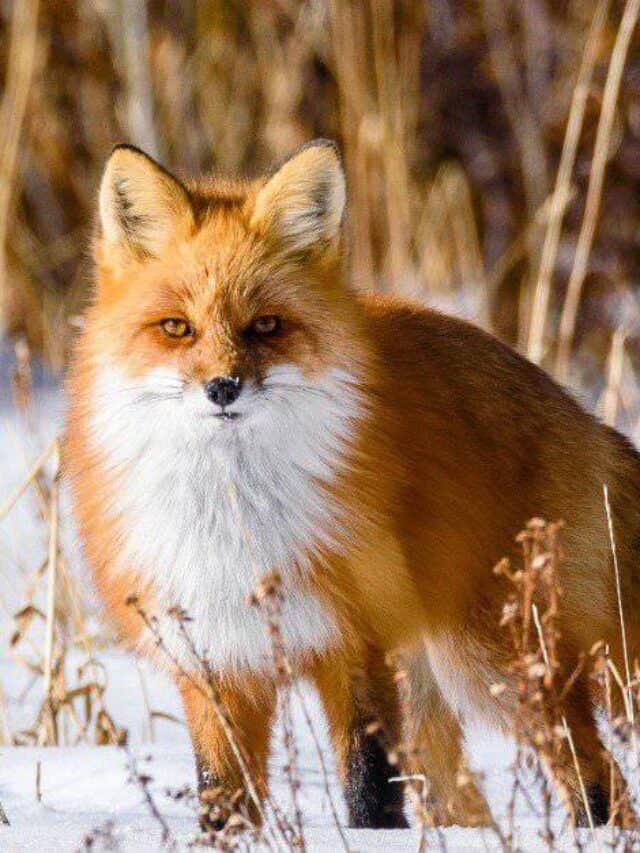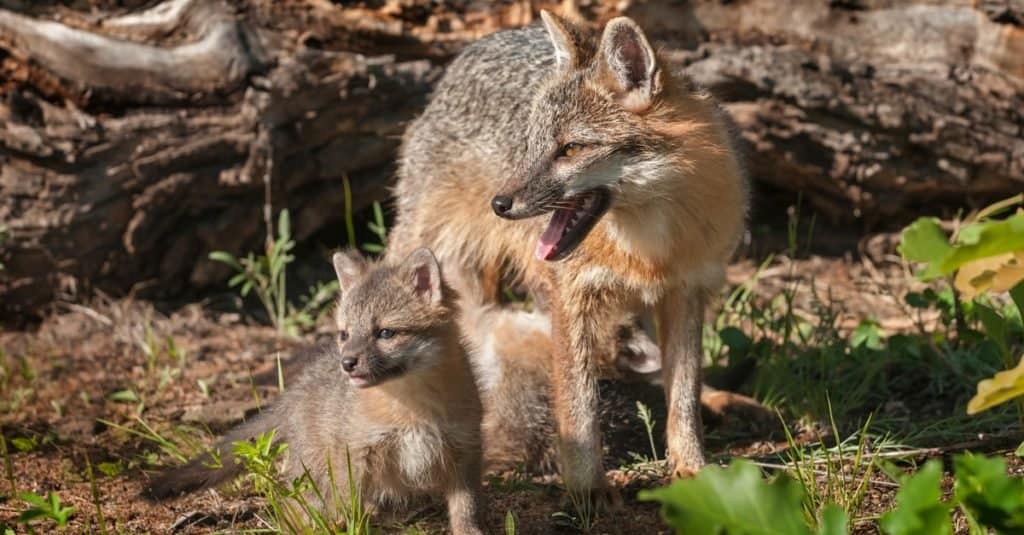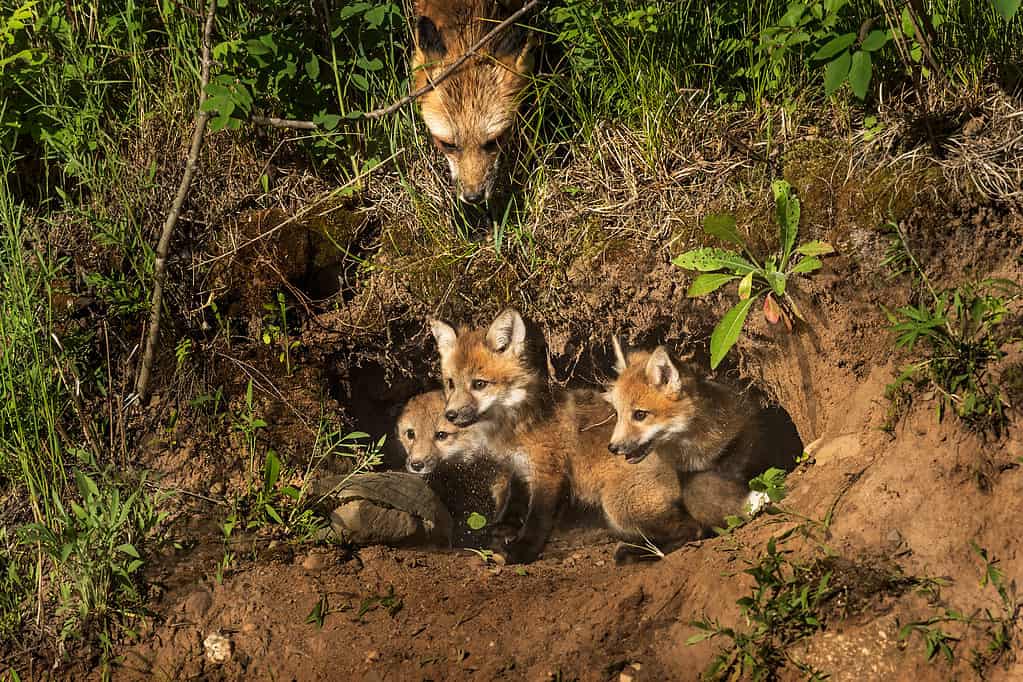While the focus of this blog is on foxes in Rhode Island, it’s worth providing some context on the state itself. Rhode Island is the smallest state in America by land area, but don’t let its size fool you – it’s densely populated and boasts a rich history. The state has a diverse economy that includes industries such as healthcare, education, tourism, and manufacturing. Known for its picturesque coastline and charming small towns (like Newport), Rhode Island also has several urban areas, including Providence, the capital city and largest metropolitan area. With plenty of options for outdoor activities like hiking, fishing, boating, or simply enjoying the beach life during summer months, there is no shortage of things to do in this beautiful New England state.
2 Types of Foxes in Rhode Island
Two species of fox live in Rhode Island, the red fox (Vulpes vulpes) and the gray fox (Urocyon cinereoargenteus).
Red Fox

Red foxes live in Rhode Island.
©iStock.com/Hawk Buckman
The red fox (Vulpes vulpes) is a species of fox that is found in many parts of the world, including North America. It is one of the most widely distributed mammals on the planet and can be found in a variety of habitats ranging from forests to grasslands to urban areas.
As its name suggests, the red fox has reddish-orange fur on its back and sides with white underparts. Its tail is often tipped in white or black, and it has pointed ears with black tips. The males are typically larger than the females.
Red foxes are opportunistic predators that feed on a wide variety of food items, such as small mammals, birds, rodents, rabbits, insects, and even fruits. They have also been known to scavenge for food when necessary.
In terms of behavior, red foxes are solitary animals, but they may form pairs during the breeding season, which begins between December and February, depending on location. After mating occurs, the female will give birth to litters consisting of anywhere from 1-13 kits. However, the average litter size ranges between 4-6 kits which she raises inside her den for several weeks before becoming independent enough to venture out into their surroundings.
Overall, despite being frequently hunted by humans for their pelts or as pests due to livestock predation issues, red fox populations continue thriving across much of North America today thanks partly due habitat conservation efforts.
Gray Fox

Gray Fox (Urocyon cinereoargenteus) lives in Rhode Island.
©Danita Delimont/Shutterstock.com
The gray fox, scientifically known as Urocyon cinereoargenteus, is a fascinating species of fox that can be found in Rhode Island and several other regions of North America. This medium-sized mammal has a unique appearance with its grizzled gray fur, black-tipped tail, and reddish-brown legs. One notable feature of the gray fox is its ability to climb trees. This trait sets it apart from most other members of the Canidae family.
Gray foxes are primarily nocturnal animals that prefer wooded areas with dense undergrowth for cover and protection. They are omnivores that feed on a variety of food sources, including small mammals like rabbits and rodents, insects, fruits, berries, and even carrion. Gray foxes have an acute sense of hearing which helps them locate prey or potential predators in their environment.
During the breeding season (typically December through February), male gray foxes will establish territories ranging from 1 to 3 square miles in size. Females give birth to litters typically consisting of 2-5 pups after a gestation period lasting around two months.
Despite being relatively common in certain parts of North America, such as Rhode Island, where they thrive due to suitable habitats and low human population density affecting their natural habitat less frequently than suburbanized areas across the United States but still face threats such as habitat loss due to urbanization or agriculture expansion leading towards decline over time if not protected properly by conservation efforts aiming at balancing development needs while preserving natural wildlife.
How to Tell Them Apart

Gray foxes are a bit shorter and stockier than red foxes.
©Holly Kuchera/Shutterstock.com
If you’re trying to identify a fox in Rhode Island, there are two species that you might encounter: the gray fox and the red fox. While they share some physical characteristics, there are a few key differences that can help you tell them apart.
Both types of foxes have pointed muzzles, erect ears, and fluffy tails with white markings on their cheeks and bellies. They also have similar lifespans, typically living for 4-5 years in the wild. However, when it comes to size and appearance, there are some distinct features that set these two species apart.
The gray fox is generally stockier than its red cousin. It has shorter legs and fur that’s mostly gray with reddish-brown flecks on its ears, sides, legs, and chest. The tail of a gray fox is black-tipped. In terms of size, both males and females can range from 27-45 inches in length and weigh between 6-15 pounds.
On the other hand, the red fox is more slim with longer legs relative to its body size. Its fur color ranges from orange-red to orange and black. However, all individuals will have black markings on their feet as well as behind their ears. The tip of a red fox’s tail is usually white, making it easy to spot if you catch sight of one running through fields or forests around Rhode Island.
Where are Foxes in Rhode Island?

A mother red fox typically has 4-6 kits per litter.
©Geoffrey Kuchera/Shutterstock.com
Rhode Island is home to both species of fox, the red and gray fox. These furry creatures can be found in all mainland communities throughout the state. However, if you’re hoping to spot a red fox on your visit to Rhode Island, you may also want to consider visiting Aquidneck Island, Jamestown, or Prudence Island in Narragansett Bay, where this particular species has been reported.
In contrast, while the gray fox was previously only known for its presence in Jamestown, there are no recent records for this species from Conanicut Island. Unfortunately, neither species can be found on some of the smaller islands surrounding Narragansett Bay, such as Block Island.
It’s worth noting that despite their cute and playful appearance, foxes should not be approached or fed by humans as they are wild animals with sharp teeth and claws. Instead, it’s best to admire them from afar and let them go about their daily lives undisturbed.
Diet

Fox vocalizations include yips and barks, which can travel great distances.
©Giedriius/Shutterstock.com
Foxes are known to be opportunistic hunters and scavengers, meaning that they will eat anything from small rodents and birds to insects and fruits. Their diet can vary depending on the season and their location. In Rhode Island, foxes have been observed eating a variety of prey, including rabbits, squirrels, chipmunks, mice, voles, shrews, moles, birds (especially ground-nesting birds), fish (when near water sources), snakes, and even carrion.
Foxes use their keen senses of sight and hearing to locate prey. They also rely heavily on their sense of smell when hunting for food. Once they spot potential prey or detect its scent trail, foxes will either stalk it or dig into burrows to catch it by surprise. They may also pounce on small animals like mice or rabbits as they scurry across open spaces.
Despite being skilled hunters in the wild, urban foxes have adapted well to living in human-populated areas where they often feed on waste food found in trash cans or pet dishes left outside. This behavior has led some experts to suggest that these animals may be becoming more omnivorous over time due to increased exposure to human foods.
Overall though, despite their reputation as cunning predators with sharp teeth and claws at the ready for any opportunity that presents itself – foxes lead primarily solitary lives marked by periods of rest punctuated by bursts of activity during which they hunt for food before returning home again until another day begins anew!
Other Wildlife in Rhode Island

White-tailed deer live in Rhode Island.
©Tony Campbell/Shutterstock.com
Rhode Island is a state that boasts an incredible diversity of wildlife, with over 800 different species inhabiting its forests, fields, and coastal areas. From the beautiful black bear to the elusive coyote, Rhode Island’s animal kingdom is as varied as it is impressive.
Other notable wildlife species in Rhode Island include beavers, white-tailed deer, bats, and skunks. The state also has a wide variety of bird species, such as great blue herons, ospreys, and piping plovers.
In addition to these larger animals, there are plenty of smaller creatures that call Rhode Island home. This includes reptiles like turtles and snakes, amphibians such as frogs and salamanders, and even insects like butterflies and bees.
Whether you’re exploring one of Rhode Island’s many nature reserves or simply taking a stroll through your local park, keep your eyes peeled for the abundance of wildlife that surrounds us here in this beautiful state.
The photo featured at the top of this post is © JayPierstorff/Shutterstock.com
Thank you for reading! Have some feedback for us? Contact the AZ Animals editorial team.






